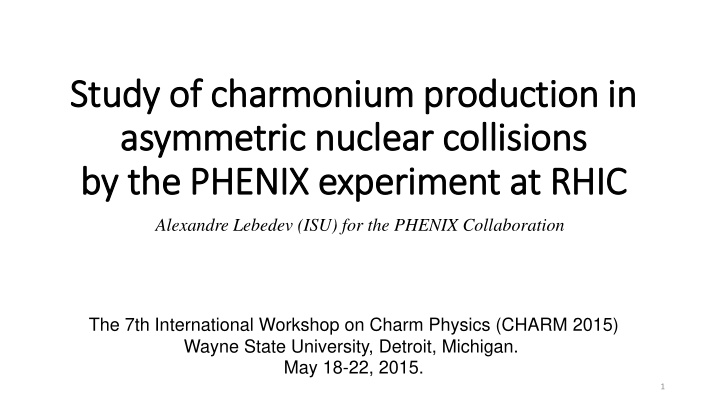



Study of charmonium production in in asymmetric nuclear collisions by the PHENIX experiment at RHIC Alexandre Lebedev (ISU) for the PHENIX Collaboration The 7th International Workshop on Charm Physics (CHARM 2015) Wayne State University, Detroit, Michigan. May 18-22, 2015. 1
Quarkonia as a Probe of f Deconfined Matter Dissociation of quarkonia by color screening in deconfined matter is predicted to be different for different states. Loosely bound states melt first. Successive suppression of individual states provides a “thermometer” of the QGP. Excellent tool to probe QGP…. …but only if we know all he references. Mocsy & Petreczky Many competing processes in AA collisions: PRL. 99, 211602 (2007) cold nuclear matter effects, color screening, initial state effects, regeneration, feed-down … … need measurements for different energies, colliding species, quarkonium states. 2
The PHENIX Experiment Quarkonium states are measured via di-lepton decays Central Arms ( electrons) | h | < 0.35 Df = 2 × p/2 P > 0.2 GeV Muon Arms 1.2 < | h | < 2.2 Df = 2 p P > 2 GeV 3
d+Au collisions: a good way to study CNM PHOBOS PRC 72 , 031901(R) PRL 107, 142301 (2011) Rapidity-dependent R dAu : Forward (deuteron going) rapidity shows more suppression than central and backward (Au going) rapidity. Many possible explanations, including nuclear breakup, gluon shadowing, etc… A reasonable agreement with EPS09 nPDF + σ br = 4 mb 4
d+Au collisions: a good way to study CNM (2 (2) Centrality dependence: agreement with EPS09 nPDF + σ br = 4mb PRL 107, 142301 (2011) only for central collisions but not for peripheral. Gluon saturation explains centrality dependence for forward rapidity. R dAu rises up to 5GeV/c; largest disagreement with theories at backward rapidity. Shadowing + s br does not match the trend. The model by Kopeliovoich et al. includes Cronin and s br qualitatively matches the shape 5
y ’ in d+Au at mid-rapidity PRL 111, 202301 (2013) Peripheral d+Au Central d+Au Unexpectedly , y ’ is ~3 times more suppressed in most central collisions than J/ y . Very different trend with N COLL . 6
Nuclear crossing time in d+Au Universal trend with dN ch /d h for several PRL 111, 202301 (2013) systems, up to 200 GeV. Breakup by nucleus Time spent in nucleus (breakup) does not hold as explanation for PHENIX data. Similar trend at LHC: E. Scomparin, INT 2014 7
y ’ in Cu+Au (w (work in progress) PHENIX is working on extracting y ’ yields in Cu+Au collisions at forward/backward rapidity. The analysis involves the new Forward Vertex Detector (FVTX). Still work in porogress; y ’ peak can be seen in peripheral collisions. 8
J/ y in Cu+Au: J/ : is R AA AA still asymmetric? arXiv:1404.1873 Cu-going Au-going Interplay between “hot” and cold nuclear matter effects. 1) Asymmetric CNM effects. 2) HNM effects possibly asymmetric. Higher suppression in region of lower particle density (forward rapidity), similar to d+Au collisions. Debye screening would go in other direction. 9
J/ y in Cu+Au compared to Au+Au J/ arXiv:1404.1873 Similar or stronger (?) suppression in peripheral Cu+Au, but becomes equal in central collisions. 10
J/ y in Cu+Au: Cu-going/Au-going ratio J/ CNM = EPS09 + 4mb breakup (Phys. Rev. C84, 044911, 2011) Observed R decreases with centrality. R = Cu-going R AA / Au-going R AA Au-going direction : low-x partons in Cu nucleus and high-x partons in Au nucleus. Cu-going direction: low-x partons in Au nucleus and high-x partons in the Cu arXiv:1404.1873 nucleus. 11
U+U Collisions Collisions of deformed U nuclei produce wide variation in energy density within the same colliding system. PRC 84 , 054907 (2011) MC studies show [e.g. PRC 76 , 051902 (2007)] a possibility of selecting experimentally tip-tip collisions (high multiplicity, low flow). Averaged over orientation energy In tip-tip collisions T/T C could be reach above 2 density is 15-20% higher than in Au+Au [ PRC 84 , 054907 (2011)] at which U (1S) could dissociate. 12
J/ y in U+U J/ Qualitatively similar suppression from Cu+Cu to U+U. Somewhat weaker suppression in central U+U collisions? Higher coalescence? 13
Conclusions and Outlook Significant suppression of J/ y in d-Au. In Cu+Au collision, the Cu going side is more suppressed than Au going side due to CNM effects, sensitive to the low x of the Au nuclei. The magnitude and trend of ψ (2s) suppression in nuclear collisions is quite different from J/ ψ. Nuclear crossing time does not explain the data. J/ y R AA is qualitatively consistent between different colliding systems, from Cu+Cu to U+U. ~20% differences despite expected variations in the CNM and QGP effects. Recombination is important? Potentially interesting to try to select tip-tip U+U collisions. 14
backup slides 15
y ’ in Cu+Au 16
y ’ in Cu+Au 17
18
d+Au 19
Recommend
More recommend